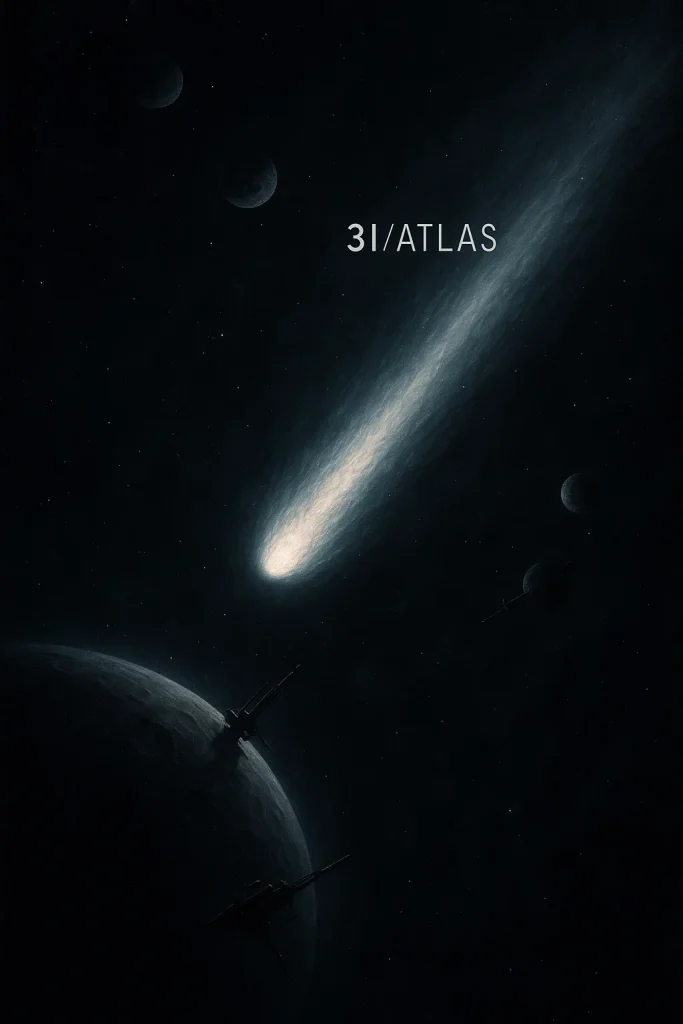⏲️ Estimated reading time: 3 min
3I/ATLAS: The Third Interstellar Visitor Reveals Its Secrets. Discover the story of 3I/ATLAS our solar system’s third confirmed interstellar comet. From its fiery origin and record-setting speed to mysterious water emissions and ancient origins, learn what makes this cosmic traveler a window into the galaxy’s past.
In July 2025, astronomers detected a rare and intriguing interstellar traveler: 3I/ATLAS. This cosmic wanderer, only the third known interstellar object after ‘Oumuamua and 2I/Borisov, has been captivating scientists with its remarkable trajectory, composition, and origin story.
1. Discovery and Identification
- 3I/ATLAS (formally C/2025 N1) was discovered on 1 July 2025 by the ATLAS robotic telescope system in Chile (Wikipedia, arXiv).
- Precovery images from TESS and the Vera C. Rubin Observatory track it back to early May and June 2025 (Wikipedia).
2. Fast and Far: Its Trajectory and Speed
- Hurtling through space at around 130,000 mph (209,000 km/h) the fastest interstellar object recorded (NASA Science).
- It follows a hyperbolic, unbound trajectory, confirming its interstellar origin (Wikipedia).
3. Approaches and Close Encounters
- Perihelion the closest point to the Sun is expected on 29 October 2025, at about 1.36 AU (Wikipedia).
- Other notable flybys:
4. Size and Physical Characteristics
- Observations from the Vera C. Rubin Observatory suggest the nucleus is approximately 7 miles (11.2 km) in diameter the largest interstellar object observed so far (Live Science).
- Hubble and other instruments provide varying nuclear size estimates, but the consensus confirms a massive, active cometary body (Wikipedia, Live Science).
5. Composition & Activity
- The coma (dusty envelope) appears reddish, indicating complex organic material reminiscent of trans‑Neptunian objects and active comets (arXiv).
- Water activity has been confirmed:
- Ultraviolet detection of OH emissions and water vapor at ~3.5 AU (arXiv).
- Dust grains and large icy particles contribute to outgassing even at great distances (arXiv).

6. Age and Origin
- Likely formed in the Milky Way’s thick disk, suggesting it could be 7–14 billion years old perhaps older than our Solar System (Wikipedia).
- Its trajectory and velocity components reinforce a low-metallicity, ancient origin, typical of thick‑disk stars (Wikipedia).
7. Speculation and Scientific Debate
- A speculative paper by Avi Loeb raised the possibility of 3I/ATLAS being an alien probe, citing “anomalous characteristics.” Many astronomers swiftly criticized the claim as unsubstantiated (Wikipedia).
- The mainstream interpretation remains that 3I/ATLAS is a natural, cometary object (Wikipedia).
8. Future Observations & Missions
- Juno spacecraft may be capable of intercepting or studying 3I/ATLAS near Jupiter in March 2026, though challenges remain (arXiv).
- Upcoming observations:
- James Webb Space Telescope (JWST) scheduled for August and December 2025 to study the comet’s composition via infrared spectroscopy (Wikipedia).
- Hubble Space Telescope will continue monitoring UV emissions post‑perihelion (Wikipedia, NASA Science).
3I/ATLAS is more than just an interstellar visitor it’s a cosmic time capsule. From its extraordinary speed and size to its ancient nature and dynamic activity, this comet offers a rare glimpse into planetary formation beyond our own Solar System. With upcoming observations and potential spacecraft rendezvous, astronomers are poised to unlock even more secrets from this remarkable interstellar traveler.
🔔For more tutorials like this, consider subscribing to our blog.
📩 Do you have questions or suggestions? Leave a comment or contact us!
🏷️ Tags: 3I/ATLAS, interstellar comet, astronomy, space science, comet discovery, water in space, astro-composition, ancient comet, Juno mission, James Webb Space Telescope
📢 Hashtags: #3IATLAS #InterstellarComet #AstronomyNews #SpaceExploration #CometDiscovery #WaterInSpace #JWST #JunoMission #Astronomy #CosmicTravel
Only logged-in users can submit reports.
Discover more from HelpZone
Subscribe to get the latest posts sent to your email.

